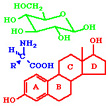Future ApplicationsThe future of combinatorial chemistry will undoubtedly provide a wealth of pre-clinical lead compounds and potential drugs. Advances thus far in combinatorial techniques will shift drug discovery from the normal time-consuming/labor-oriented synthesis to accelerated synthesis of a multitude of compounds that can be screening and optimized quickly.
Will all possible compounds be prepared within the next 10 or 50 years? In the past 50 years Chemical Abstracts have recorded only several million pure compounds, but what will be left if one chemist can make that many in one day? No problem.
The variety that exists is unimaginable. If one thinks only about one class of compounds peptides the number of possible different D and L diastereomers will exceed the number of atoms in the universe, even before one reached a peptide of 100 units.

Or there are steroids which can have different attachment points and different side chains with different stereochemistry on the A, B, C, or D ring. This is why some rationale needs to be included in the thought behind the synthesis so that you have a directed path and you do what is essential. More Details....Room for Improvement?
Combinatorial chemistry is not refined completely yet it is still developing. Lets look at the applicable stages of drug discovery and where combinatorial does or does not fall short.
1. The first stage is finding promising lead compounds, which is facilitated greatly with the compilation of the combinatorial libraries. The library can also takes the lead compound and derivatize it to give it pharmacological properties that are necessary for a potential drug.
2. The second step - lead development is where combinatorial chemistry begins to fall short of ideal. As the lead molecule becomes more complex, problems that can arise are difficulties with detaching the structurally diverse molecules from the solid support, unfavorable side reactions, and harmful effects that often occur in the harsh reaction conditions employed by combinatorial syntheses. These problems magnify if the natural product happens to be sensitive and fragile. Solutions to these conditions are being studied in combinatorial biocatalysis which employs enzymatic conditions and microbial transformations on an existing lead instead of the more harsh organic reaction conditions. [1]
Is Combinatorial Chemistry Worth It?
Analytical methods, like GC/MS, LC/MS, MS/MS, etc. for small scale reactions are constantly improving so that our synthetic characterization is optimized. Combinatorial method is also a relatively current innovation, and thus with practice comes perfect. So if combinatorial methods were not perceived to be valuable, then companies would not have made the investments that they have to advance combinatorial chemistry.
1) Chaiken, I.M. ed. and Janda, K.D. ed. Molecular Diversity and Combinatorial Chemistry. American Chemical Society. Washington D.C. 1996. Chapter 14
HomeWhat is Combinatorial Chemistry?
-- Solid Phase Synthesis
-- Future Applications of Combinatorial ChemistryMedicines Derived from Combinatorial Chemistry
The Value of The Rainforests
The Fate of the Rainforest